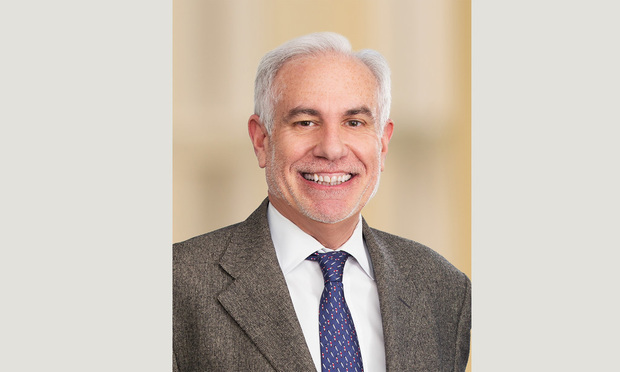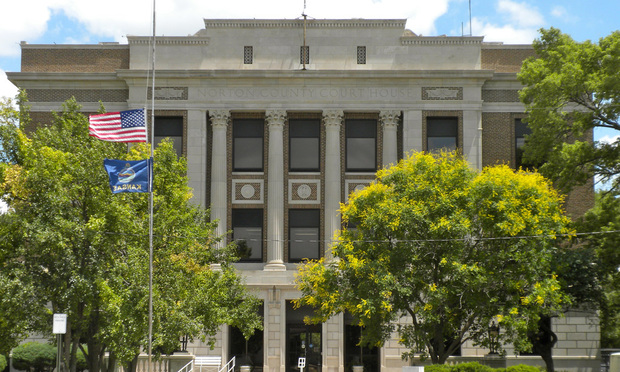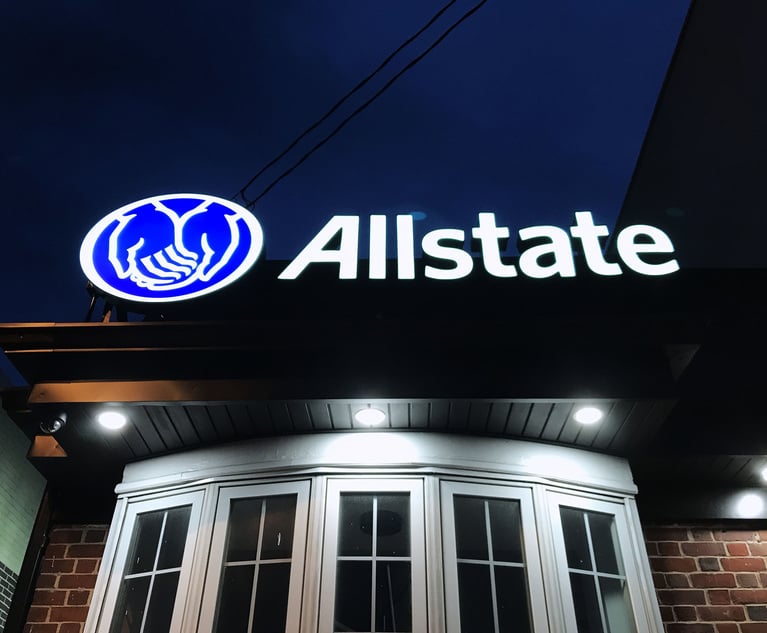Saying Things Without Words: The Meaning of Legal Spaces
Traditional courthouse design is somewhat at odds with current notions of transparency, justice-as-fairness and inclusion.
July 13, 2020 at 06:33 PM
6 minute read
 Randy D. Gordon, partner at Barnes & Thornburg and executive professor of law and history at Texas A&M University. (Courtesy photo)
Randy D. Gordon, partner at Barnes & Thornburg and executive professor of law and history at Texas A&M University. (Courtesy photo)
Public statues—in their ubiquity when coupled with the human tendency to habituate the familiar—are as consciously unnoticed as individual trees. But that doesn't mean that they don't mean anything. This summer, sculptures of Confederate officers, slaveholding founders, long-dead public figures who expressed racist views, Old World explorers, and—in proof that all movements have absurdities at the margins—Melania Trump have been pulled down or defaced (or, in the case of Trump's Slovenian wood-carving, burned).
Does a sculpture of Robert E. Lee represent "history" or idealize and sanitize "oppression"? Does a sculpture of Christopher Columbus represent a point of pride for Italian Americans or an affront to Native Americans? Both? Or even more?
I can't hope to resolve the dispute, but it does offer us a springboard into a topic that has attracted my interest of late—namely, the way that courthouses and courtrooms mean. For instance, the manuscript of my new book project, "Everyday Lawyering: Where Imagination and Morality Meet Advocacy and Logic," is currently under review at a university press. A large section of the book considers law-as-performance, which, in part, examines the spaces in which legal performances take place: trials in courtrooms. By this, I "mean" nothing more than that legal spaces transmit messages to us without using words.
We are all acculturated to associate certain architectural forms with certain institutions. And we understand that these forms convey meaning. A place of worship is perhaps the most common example—a steeple tells us we're in front of a church. But the entire structure often suggests more than merely what it is. It may even tell a story.
The great French art historian Émile Mâle wrote of the Gothic cathedral that, "All that was necessary that men should know—the history of the world from the creation, the dogmas of religion, the examples of the saints, the hierarchy of the virtues, the range of the sciences, arts and crafts—all these were taught them by the windows of the church or by the statues in the porch."
 Norton County Courthouse in Norton, Kansas.
Norton County Courthouse in Norton, Kansas.In the United States, courthouses have assumed a place of particular prominence. William Faulkner captures this sense in one of his short stories, "The Courthouse," by asserting "the focus, the hub; sitting looming in the center of the county's circumference like a single cloud in its ring of horizon, laying its vast shadow to the uttermost rim of horizon; musing, brooding, symbolic, and ponderable, tall as a cloud, solid as rock, dominating all: protector of the weak; judiciate and curb of the passions and lusts, repository and guardian of the aspirations and the hopes; rising course by brick course during that first summer."
But traditional courthouse design is somewhat at odds with current notions of transparency, justice-as-fairness and inclusion. As the Government Services Administration (which, among other things, serves as the de facto landlord of federal agencies) has noted with respect to federal buildings generally, "by the late 1960s and early 1970s, some federal buildings responded to public expectations for a 'cost-conscious, nonauthoritarian, sensitive, and inclusive government.' Anti-monumental, yet still formal, buildings that conveyed the government as welcoming, accessible, and participatory were generally lower in scale, often with clear glass that allowed views of the interiors."
With respect to courthouses, as architect Frank Greene puts it, the central challenge has been to ameliorate through innovative architecture public distrust of the legal system and thereby to reengage citizens in the democratic aspects of the process, stating "the traditional elements of American courthouses—their massive masonry construction, opacity, blocklike massing, and heroically scaled public porticos, staircases, and sculptural elements rendered in the authoritative language of neoclassical architecture—expressed the power of law but did little to communicate concern for the place of citizens in the workings of the process."
The trick, then, for modern architects, is to create a structure that, as one wag put it, "look[s] like a courthouse, not a bus station." Greene points to the Bronx County Hall of Justice (notice the name) as a paradigm of the new thinking. According to its architects, "the intent is to express the building as open and inviting, a metaphor for the transparency of the judicial process."
To execute on this intent, the Bronx County structure, which opened in 2007, was conceived as a truly "public" building, but the realities of, for example, the Oklahoma City bombing thwarted that effort. Nonetheless, transparency in the form of a glass façade—hardened to anti-ballistic strength—was retained. And, as Greene says, despite the anti-terrorism concessions, "the essential message of the new Bronx criminal courthouse—a justice system open to public scrutiny, inclusive of public participation, and dependent on the support and protection of its community—remains unchanged."
An omnipresent feature of courthouses has been the display of "justice" statuary, almost always including what is commonly referred to as "Lady Justice." Here, we find the law's exercise of violence, as represented by the sword, legitimated through its proximity to images of equal treatment of litigants and the weighing of their claims and defenses (the scales), as well as by impartiality (the blindfold). The female form rendered in a classical style, which is not historically associated with political chicanery and judicial corruption, further advances these ideals-as-universal-abstractions.
But of course the universal availability of these abstractions remains contested, as my fellow Kansan Langston Hughes' short poem "Justice" drives straight to the mark:
That Justice is a blind goddess
Is a thing to which we black are wise:
Her bandage hides two festering sores
That once perhaps were eyes.
Perhaps as troubling as the message of the poem itself is that it was first published in 1932. But perhaps as a consequence of the current social disruptions, the French epigram, plus ça change, plus c'est la même chose (the more things change, the more they stay the same), will not bear out.
Randy D. Gordon is a partner at Barnes & Thornburg and co-chairs the antitrust practice group. He is executive professor of law and history at Texas A&M University.
This article should not be construed as legal advice or legal opinion on any specific facts or circumstances. The contents are intended for general informational purposes only, and you are urged to consult your own lawyer on any specific legal questions you may have concerning your situation.
This content has been archived. It is available through our partners, LexisNexis® and Bloomberg Law.
To view this content, please continue to their sites.
Not a Lexis Subscriber?
Subscribe Now
Not a Bloomberg Law Subscriber?
Subscribe Now
NOT FOR REPRINT
© 2025 ALM Global, LLC, All Rights Reserved. Request academic re-use from www.copyright.com. All other uses, submit a request to [email protected]. For more information visit Asset & Logo Licensing.
You Might Like
View All
5th Circuit Strikes Down Law Barring Handgun Sales to Adults Under 21


Read the Document: DOJ Releases Ex-Special Counsel's Report Explaining Trump Prosecutions
3 minute read
Special Counsel Jack Smith Prepares Final Report as Trump Opposes Its Release
4 minute readLaw Firms Mentioned
Trending Stories
- 1New FCC Chair Hires Section 230 Critic as General Counsel
- 2Sylvia Favretto Elevated to Mysten Labs’ General Counsel
- 3Vanessa Roberts Avery Rejoins McCarter & English
- 4Charlie Javice Jury Will Not See Her Texts About Elizabeth Holmes
- 5Unit Owners Sued Board For Failure To Maintain Adequate Fire Insurance: This Week In Scott Mollen’s Realty Law Digest
Who Got The Work
J. Brugh Lower of Gibbons has entered an appearance for industrial equipment supplier Devco Corporation in a pending trademark infringement lawsuit. The suit, accusing the defendant of selling knock-off Graco products, was filed Dec. 18 in New Jersey District Court by Rivkin Radler on behalf of Graco Inc. and Graco Minnesota. The case, assigned to U.S. District Judge Zahid N. Quraishi, is 3:24-cv-11294, Graco Inc. et al v. Devco Corporation.
Who Got The Work
Rebecca Maller-Stein and Kent A. Yalowitz of Arnold & Porter Kaye Scholer have entered their appearances for Hanaco Venture Capital and its executives, Lior Prosor and David Frankel, in a pending securities lawsuit. The action, filed on Dec. 24 in New York Southern District Court by Zell, Aron & Co. on behalf of Goldeneye Advisors, accuses the defendants of negligently and fraudulently managing the plaintiff's $1 million investment. The case, assigned to U.S. District Judge Vernon S. Broderick, is 1:24-cv-09918, Goldeneye Advisors, LLC v. Hanaco Venture Capital, Ltd. et al.
Who Got The Work
Attorneys from A&O Shearman has stepped in as defense counsel for Toronto-Dominion Bank and other defendants in a pending securities class action. The suit, filed Dec. 11 in New York Southern District Court by Bleichmar Fonti & Auld, accuses the defendants of concealing the bank's 'pervasive' deficiencies in regards to its compliance with the Bank Secrecy Act and the quality of its anti-money laundering controls. The case, assigned to U.S. District Judge Arun Subramanian, is 1:24-cv-09445, Gonzalez v. The Toronto-Dominion Bank et al.
Who Got The Work
Crown Castle International, a Pennsylvania company providing shared communications infrastructure, has turned to Luke D. Wolf of Gordon Rees Scully Mansukhani to fend off a pending breach-of-contract lawsuit. The court action, filed Nov. 25 in Michigan Eastern District Court by Hooper Hathaway PC on behalf of The Town Residences LLC, accuses Crown Castle of failing to transfer approximately $30,000 in utility payments from T-Mobile in breach of a roof-top lease and assignment agreement. The case, assigned to U.S. District Judge Susan K. Declercq, is 2:24-cv-13131, The Town Residences LLC v. T-Mobile US, Inc. et al.
Who Got The Work
Wilfred P. Coronato and Daniel M. Schwartz of McCarter & English have stepped in as defense counsel to Electrolux Home Products Inc. in a pending product liability lawsuit. The court action, filed Nov. 26 in New York Eastern District Court by Poulos Lopiccolo PC and Nagel Rice LLP on behalf of David Stern, alleges that the defendant's refrigerators’ drawers and shelving repeatedly break and fall apart within months after purchase. The case, assigned to U.S. District Judge Joan M. Azrack, is 2:24-cv-08204, Stern v. Electrolux Home Products, Inc.
Featured Firms
Law Offices of Gary Martin Hays & Associates, P.C.
(470) 294-1674
Law Offices of Mark E. Salomone
(857) 444-6468
Smith & Hassler
(713) 739-1250






